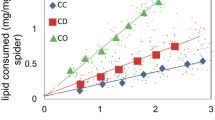Summary
The webs of Miagrammopes animotus have a simple structure and variable form. However, both the length of their lines and the total surface area of their capture threads are closely associated with spider size. These spiders' ability to deposit both linear and looped cribellar capture threads along a web's diverging capture lines plays an important role in establishing these relationships. Looped capture threads have the greater surface area and are more prominent in the webs of older spiders where they increase a web's surface area and enhance its ability to retain prey. The predicted performance of these webs is supported by comparisons of the stickiness of their threads and a survey of the prey their owners capture. Cribellar thread stickiness increases with spider size, and larger spiders capture prey that have greater masses.
Similar content being viewed by others
References
Carico JE (1977) A simple dusting device for coating orb webs for field photography. Bull Br Arachnol Soc 4:100
Craig CL (1987) The ecological and evolutionary interdependence between web architecture and web silk spun by orb web weaving spiders. Biol J Linn Soc 30:135–162
Denny MW (1976) The physical properties of spider's silk and their role in design of orb webs. J Exp Biol 65:483–506
Eberhard WG (1976) Physical properties of sticky spirals and their connections: sliding connections in orb webs. J Nat Hist 10:481–488
Eberhard WG (1977) Aggressive chemical mimicry in a bolas spider. Science 198:1173–1175
Eberhard WG (1980) The natural history and behavior of the bolas spider Mastophora dizzydeani Sp. N. (Araneidae). Psyche 3–4: 143–169
Eberhard WG (1981) Construction behaviour and the distribution of tensions in orb webs. Bull Br Arachnol Soc 5:189–204
Eberhard WG (1986) Effects of orb-web geometry on prey interception and retention. In: Shear WA (ed) Spiders: webs, behavior, and evolution. Stanford University Press, Stanford, pp 70–100
Langer RM (1969) Elementary physics and spider webs. Am Zool 9:81–89
Lubin YD (1986) Web building and prey capture in Uloboridae. In: Shear WA (ed) Spiders: webs, behavior, and evolution. Stanford University Press, Stanford, pp 132–171
Lubin YD, Eberhard WG, Montgomery GG (1978) Webs of Miagrammopes (Araneae: Uloboridae) in the neotropics. Psyche 85:1–23
Opell BD (1979) Revision of the genera and tropical American species of the spider family Uloboridae. Bull Mus Comp Zool 148:433–549
Opell BD (1984) Phylogenetic review of the genus Miagrammopes sensu lato (Araneae: Uloboridae). J Arachnol 12:229–240
Opell BD (1987) Changes in web-monitoring forces associated with web reduction in the spider family Uloboridae. Can J Zool 65:1028–1034
Opell BD (1989a) Functional associations between the cribellum spinning plate and prey capture threads of Miagrammopes animotus (Araneida, Uloboridae). Zoomorphology 108:263–267
Opell BD (1989b) Measuring the stickiness of spider prey capture threads. J Arachnol 17:112–114
Peters HM (1983) Struktur und Herstellung von Fangfäden cribellater Spinnen. Verb Naturw Ver Hamburg (NF) 26:241–253
Peters HM (1984) The spinning apparatus of Uloboridae in relation to the structure and construction of capture threads (Arachnida, Araneida). Zoomorphology 104:96–104
Peters HM (1986) Fine structure and function of capture threads. In: Nentwig N (ed) Ecophysiology of spiders. Springer, Berlin Heidelberg New York, pp 187–202
Stowe MK (1986) Prey specialization in Araneidae. In: Shear WA (ed) Spiders: webs, behavior, and evolution. Stanford University Press, Stanford, pp 101–131
Author information
Authors and Affiliations
Rights and permissions
About this article
Cite this article
Opell, B.D. Material investment and prey capture potential of reduced spider webs. Behav Ecol Sociobiol 26, 375–381 (1990). https://doi.org/10.1007/BF00170893
Received:
Accepted:
Issue Date:
DOI: https://doi.org/10.1007/BF00170893




